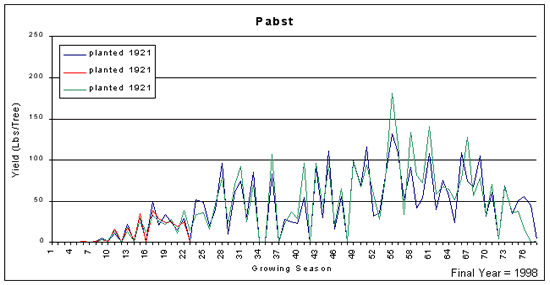Pabst

Average nut quality of test trees.
| # Nuts / lb. | % Kernel | Kernel quality breakdown | Specific gravity | ||
| % Fancy | % Standard | % Amber | |||
| 57 | 45% | 20% | 24% | 2% | .80 |
History
The original tree was planted by businessman Wm. B. Schmidt at his country home in Jackson County, Miss. in 1875. From this orchard was selected the 'Pabst' and 'Success' cultivars. Nurseryman C.E. Pabst selected and propagated distributed the future 'Pabst' cultivar in 1890 (Kenknight, 1970).
Comments
*Note: This is an older cultivar planted in the Old Variety Test at the Tifton Campus. Trees were planted decades ago when care was very different than it is now, and trees received much less care, so production data will reflect this fact. Trees began receiving insecticides in 1962, fungicides in 1970, nitrogen in 1962, and drip irrigation in 1975. The data for this cultivar was collected by several individuals, but the bulk of the data and the comments are from my predecessor Dr. Ray Worley. This information was originally published here: Worley and Mullinix, 1997.
Yields in our orchards were second to 'Stuart' at 74 years of age. The nut is about the size of 'Stuart' with a thick shell and low percent kernel (45). Nuts are well filled and attractive for the in-shell trade. The tree has tremendous size, but it is very susceptible to scab and powdery mildew. A good old variety, nut no longer recommended.
Production record of test trees beginning in year planted

'Pabst' production from the Old Variety Test. Each colored line represents the yearly production in pounds of nuts from an individual tree beginning the year planted.
Alternate Bearing Intensity* = 0.35
*Computed from mature trees using data from years after trees began receiving fertilizer and pesticide sprays.
